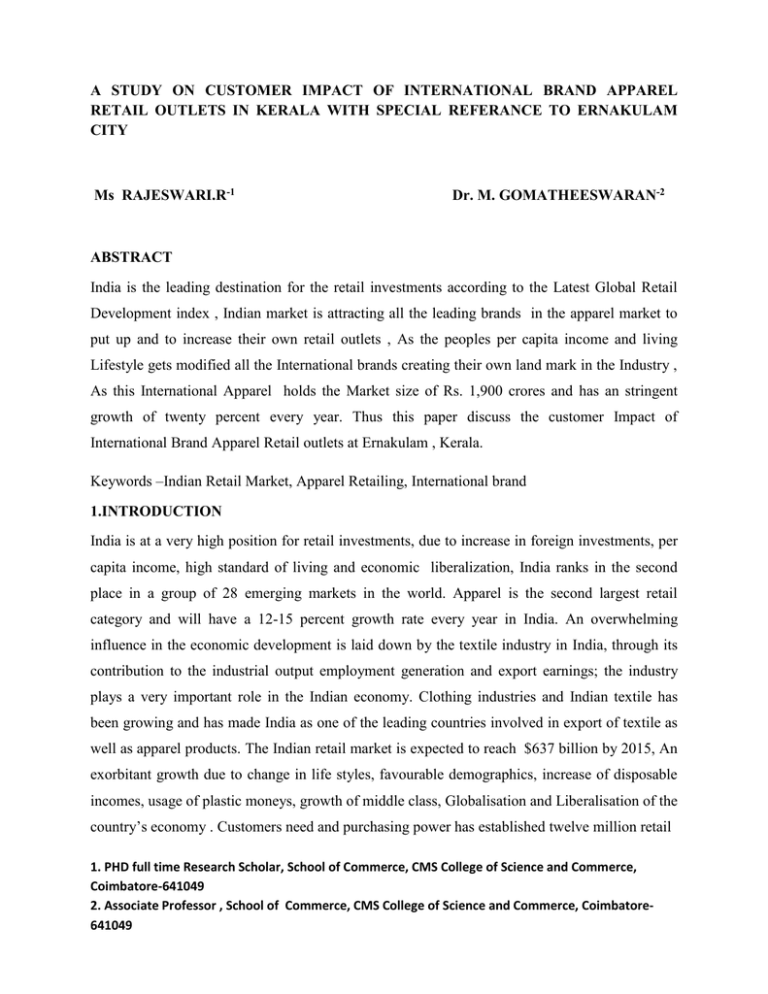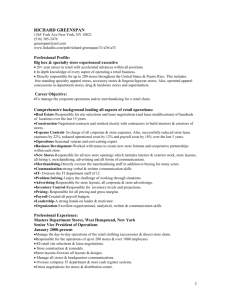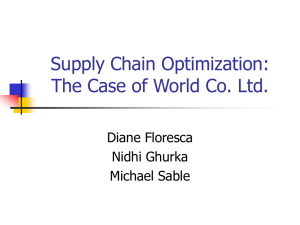3639study on customer IMPACTfinal 123
advertisement

A STUDY ON CUSTOMER IMPACT OF INTERNATIONAL BRAND APPAREL RETAIL OUTLETS IN KERALA WITH SPECIAL REFERANCE TO ERNAKULAM CITY Ms RAJESWARI.R-1 Dr. M. GOMATHEESWARAN-2 ABSTRACT India is the leading destination for the retail investments according to the Latest Global Retail Development index , Indian market is attracting all the leading brands in the apparel market to put up and to increase their own retail outlets , As the peoples per capita income and living Lifestyle gets modified all the International brands creating their own land mark in the Industry , As this International Apparel holds the Market size of Rs. 1,900 crores and has an stringent growth of twenty percent every year. Thus this paper discuss the customer Impact of International Brand Apparel Retail outlets at Ernakulam , Kerala. Keywords –Indian Retail Market, Apparel Retailing, International brand 1.INTRODUCTION India is at a very high position for retail investments, due to increase in foreign investments, per capita income, high standard of living and economic liberalization, India ranks in the second place in a group of 28 emerging markets in the world. Apparel is the second largest retail category and will have a 12-15 percent growth rate every year in India. An overwhelming influence in the economic development is laid down by the textile industry in India, through its contribution to the industrial output employment generation and export earnings; the industry plays a very important role in the Indian economy. Clothing industries and Indian textile has been growing and has made India as one of the leading countries involved in export of textile as well as apparel products. The Indian retail market is expected to reach $637 billion by 2015, An exorbitant growth due to change in life styles, favourable demographics, increase of disposable incomes, usage of plastic moneys, growth of middle class, Globalisation and Liberalisation of the country’s economy . Customers need and purchasing power has established twelve million retail 1. PHD full time Research Scholar, School of Commerce, CMS College of Science and Commerce, Coimbatore-641049 2. Associate Professor , School of Commerce, CMS College of Science and Commerce, Coimbatore641049 outlets spread across the country, These Retail Segment is the second largest employment provider after agriculture. Major shares and Foreign Direct Investment has been attracted by Food, Grocery and Apparel retailing. According to the report of AT Kearney’s Global Retail Development Index (GRDI) 2012 India remains a high potential market in another five years with accelerated retail growth of 15-20%. Apparel retailing has both organized and unorganized retail channels after Food and Grocery. Though the market size is Very big we have only about 8 to 10 % of the Organised Retailing, As the Various International Brands such as Lacoste, Crocodile, Benneton, Dockers, Lee, Nike, Levi Strauss etc have built a retail presence in India. While many others such as Zara, Versace, Mother care, Ikea, Fendi and many others have charted out strategy to enter the Indian Retail market. Most of these brands which are entering the Indian market are targeting the premium end. Due to the growth of consumerism there is a demand for luxury goods, cosmopolitan fashions and foreign brands. India’s consumer demand is increasing three to five times faster than its economy, a feature of an aspiring middle class that is young, vibrant and growing. one of the main characteristics of India is its young population. Seventy percent of India’s citizens are less than 36 years old. The country holds 20 percent of the world’s population under the age of 24. 1.1 STATEMENT OF THE PROBLEM In the present situation global retailers have become more strategic in their expansion For the most part, multinational retailers are continuing their push into developing markets, and regional giants are spreading to neighboring market. The structure of apparel retail has changed dramatically in the recent past with the growth of large multi-brand apparel outlets and manufacturer brand-led chains. An attempt is made in this study to assess the customer Impact of international brand Apparel retail outlets in Kerala with special reference to Ernakulam City 1.2 OBJECTIVE OF THE STUDY To analyze the customer’s impact of international brand apparel retail outlets at Ernakulam City, Kerala 1.3 SCOPE OF THE STUDY The study has been undertaken mainly to highlight the customer impact of International brand Apparel retail outlets in kerala. The study is confined to Ernakulam district. The sample respondents are the customers of various selected retail outlets, namely: Peter England, Louis Philippe, Arrow , Lee, Levi’s, Pepe Jeans ,Wrangler, Allen Solly, Benetton, Van Heusen 1.4 METHODOLOGY & RESEARCH DESIGN The methodology to be adopted for a particular area would depend upon the purpose and objectives to be achieved. Based on the objectives and the hypothesis to be tested, the required data have been gathered from both primary and secondary sources. Primary data were collected from questionnaires and very few data would be collected from secondary sources like newspapers, magazines, journals, books and websites etc. The sample size restricted to 250 customers in various International Brand Apparel Retail Outlets at Ernakulam ,Kerala . A convenient random sampling technique has been used for this study. 1.5 FRAMEWORK ANALYSIS On the basis of data collected, the data has been analyzed by using statistical techniques and tests have been conducted . The objectively collected data have been suitably classified and analyzed in tables. Discriminant Function Analysis is the statistical tool used for analyzing data. 1.6 LIMITATION OF THE STUDY This is an empirical study on customer’s impact of International brand apparel retail outlets in Kerala with special reference to Ernakulam district. Due to limitations of time and money consideration, the sample size has been restricted to 250 customers. Many respondents have been unable to provide proper answer with insight due to lack of knowledge about the international brand apparel retail outlets. 1.7 ANALYSIS AND INTERPRETATION DISCRIMINANT FUNCTION ANALYSIS Respondent’s opinion towards impact of International brand apparel retail outlets. In the study area out of five hundred respondents were divided into two groups .ie., low level of impact of International brand apparel retail outlets and the high level of impact of International brand apparel retail outlets. The difference of opinion of the respondents in one group from the other is studied with the help of discriminant function analysis. For the purpose of the study, the following variables were selected. 1. Gender 2. Age 3. Educational Qualification 4. Occupation 5. Monthly Income 6. Household Size 7. Family structure 8. Marital status The discriminant function analysis attempts to construct a function with these and other variables so that the respondents belonging to these two groups are differentiated at the maximum. The linear combination of variables is known as discriminant function and its parameters are called discriminant function coefficients. In constructing this discriminant function all the variables which contribute to differentiate these three groups are examined. Mahalanobis minimum D2 method is based on the generalized squared Euclidean distance that adjusts for unequal variances in the variables. The major advantage of this procedure is that it is computed in the original space of the predictor (independent) variables rather than as a collapsed version which is used in the other method. Generally, all the variables selected will not contribute to explain the maximum discriminatory power of the function. So a selection rule is applied based on certain criteria to include those variables which best discriminate. Stepwise selection method was applied in constructing discriminant function which selects one variable at a time to include in the function. Before entering into the function the variables are examined for inclusion in the function. The variables which could have maximum D2 value, if entered into the function is selected for inclusion in the function. Once entered any variable already in the equation is again considered for removal based on certain removal criteria. Likewise, at each step the next best discriminating variable is selected and included in the function and any variable already included in the function is considered for removal based on the selection and removal criteria respectively. DISCRIMINANT ANALYSIS FOR THIS STUDY Discriminant function analysis involved classification problem also to ascertain the efficiency of the discriminant function analysis all the variables which satisfy the entry and removal criteria were entered into the function. Normally the criteria used to select the variables for inclusion in the function is minimum F to enter into the equation (i.e) F statistic calculated for the qualified variable to enter into the function is fixed as ≥ 1. Similarly any variable entered in the equation will be removed from the function if F statistic for the variable calculated is < 1. The two groups are defined as Group 1 - Low level Group 2 - High level The mean and standard deviation for these groups and for the entire samples are given for each variable considered in the analysis. TABLE - 1 GROUP MEANS (BETWEEN LOW AND HIGH GROUPS) S.No. Factor Low High Total Mean SD Mean SD Mean SD 1 Gender 1.34 0.48 1.38 0.49 1.36 0.48 2 Age 2.31 0.72 2.30 0.71 2.30 0.72 3 Educational Qualification 3.15 1.46 3.21 1.49 3.18 1.47 4 Occupation 2.18 1.03 2.12 0.79 2.15 0.92 5 Monthly Income 2.89 1.11 3.05 1.05 2.97 1.08 6 Household Size 2.17 0.65 2.09 0.65 2.13 0.65 7 Family structure 1.33 0.47 1.45 0.50 1.39 0.49 8 Marital status 1.31 0.47 1.40 0.49 1.36 0.48 *Source Primary Data The overall stepwise D.F.A results after all significant discriminators have been included in the estimation of discriminated function is given in the following table TABLE -2 SUMMARY TABLE BETWEEN LOW LEVEL AND HIGH LEVEL GROUPS Wilk’s Minimum D2 Step Variables entered 1 Family structure .983 .004** 2 Marital status .992 .044* *Significant at 1% level Lamda Significance The summary table indicates that variable Family structure entered in step one. Marital status entered in step two. The variables such as Family structure and marital status are significant at one per cent and five per cent significance level. All the variables are significant discriminators based on their Wilk’s lambda and D2 value. The multivariate aspect of this model is given in the following table TABLE -3 CANONICAL DISCRIMINANT FUNCTION (BETWEEN LOW AND HIGH GROUPS) Canonical Wilks correlation Lamda .158 .975 Chi -square D.F p-value 12.625 2 .002 The canonical correlation in the discriminant group can be accounted for by this model, Wilks lamda and chi square value suggest that D.F is significant at one per cent level. The variables given above are identified finally by the D.F.A as the eligible discriminating variables. Based on the selected variables the corresponding D.F coefficients are calculated. They are given in the following table. TABLE -4 DISCRIMINANT FUNCTION COEFFICIENT (BETWEEN LOW LEVEL AND HIGH LEVEL) Family structure 1.706 Marital status 1.225 (Constant) -4.034 Z = -4.034 +1.706 (Family structure) +1.225 (Marital status) Using this D.F coefficients and variables discriminating scores for two groups are found out and are called group centroids or group means For low level user (Z1) = -.161 For High level user (Z2) = .159 Discriminating factor is the weighted average of Z1, Z2 (248x Z1) + (252 xZ2) (.i.e) Z = 249+252 It is represented diagrammatically Z1 -0.161 Z 0 Low level Z2 +0.159 High level Thus to classify any respondent as to low or high user the Z score for the respondent is found out by using the equation. If the score found out for any respondent is Z0 and if the value is > Z (i.e. Z0 > Z) then it is classified into high user and if Z0<Z then (i.e. Z0<Z) it is classified into low user. Now the questions remain to be answered are 1. How efficient are the discriminating variables in the D.F.A? 2. How efficient the D.F itself is? The first equation cannot be answered directly however the discriminating power or the contribution of each variable to the function can sufficiently answer the question. For this consider the following table TABLE - 5 RELATIVE DISCRIMINATING INDEX (BETWEEN LOW LEVEL GROUP AND HIGH LEVEL GROUP) Group I Group II Unstandarised Ij=ABS (Kj) Rj=Ij/sum Mean X1 Mean X2 coefficient Mean (Xj0-Xji) Ijj*100 Family structure 1.33 1.45 1.706 -0.205 64.997 Marital status 1.31 1.40 1.225 -0.110 35.003 0.347 100 0.347 100 Items TOTAL RELATIVE DICRIMINATING INDEX For each variable the respective D.F coefficient its mean for each group and R j are given. Rj called relative discriminating index is calculated from the discriminant function coefficient and group means. Rj tells how much each variable is contributing (%) to the function. By looking at this column one Family structure is the discriminating variable and the Marital status the least discriminating variable. The second question is answered by reclassifying the already grouped individuals into low or high level using the D.F (Z) defined in the equation. This classification is called predictor group membership .In short the efficiency of the D.F is called predictor group membership. In short the efficiency of the D.F. is how correctly it predicts the respondents into distinct groups. TABLE -6 CLASSIFICATION RESULTS (BETWEEN LOW LEVEL GROUP AND HIGH LEVEL GROUP) Predicted group membership Actual group Group I Group II No. of cases Group I Group II 118 130 47.6 % 52.4% 76 176 30.2% 69.8% 248 252 Per cent of grouped case correctly classified: 58.8 per cent The above table gives the results of the re classification. The function using the variables selected in the analysis classified 8.8 per cent of the cases correctly in the respective groups. It is found that the Discriminant function analysis was applied to the respondents on low user and high user. The following factors significantly discriminate the two users. They are Family structure and marital status is significant at one per cent and five per cent significance level 1.8 FINDINGS The following are the summary of the findings of the study on the application of discriminant analysis. 1 Variables such as family structure and marital status are significant at one percent and five percent significance level. All the variables are significant discriminators based on their wilks lambada and d2 value. 2. The canonical correlation in the discriminant group can be accounted for by this model, wilks lamda and chi square value suggest that D.F is significant at one percent level. 3. Discriminant analysis applied to the respondents on low user and high user. 4. Relative discriminant index is calculated from the discriminant function coefficient and group means. SUGGESTIONS &CONCLUSION India has emerged as one of the most attractive destinations for American and European brands in the last 10 years and will continue to hold promise for the next 10 years, irrespective of the policy on FDI. Apparel, being a more brand-driven category than, food & groceries, has already seen many international brands enter India over the past 15 years despite the restrictions in the FDI policy in single-brand retail. Modern retail in the apparel segment has a share of ~19% of the total apparel market at present, compared to a mere 3% share of modern retail for the food & groceries segment, which suggests that the apparel market has already seen large brands and retailers operating and expanding. Many foreign brands present in India have, over the years, increased their sourcing from India as this gives them the benefit of shorter lead times and lower costs. Many brands have also set up their own back-end manufacturing infrastructure. This trend will continue to widen in the future as, with increasing competition, the pressure on price will increase further, forcing brands to look for ways to cut their costs. Also, with the growing fashion consciousness among Indian consumers, there will be an increased need to shorten lead times which will further force international brands to look at local sourcing options. Thus, with more international brands entering India, Employments, and Competitive pricing and different styles & collections will increase. Also, large foreign brands and retailers bring with them their best practices in supply chain, manufacturing and product design & quality. This will lead apparel industries towards an systematic approach on customers requirement and satisfaction. REFERENCES:1) MiKyeong Bae, Seung Sin Lee, Sun Young Park (2003),” The Brand Name Effect Of Consumer’s Evaluation On Intrinsic Attributes: A Case Study Of Clothing Market “,International journal of human ecology : vol. 4, no. 1, 45-54 2) Tomu Francis (2006),”FDI And ‘Single Brand Retail’” www.businessgyan.com 3) Amit Mitta, Ruchi Mitta (2008), “Store Choice In The Emerging Indian Apparel Retail Market: an Empirical Analysis”, International Black Sea University Scientific Journal, vol. 2, iss. 2, pp. 21-46 4) Ian Phau, Yip Siew Leng, (2008),” Attitudes toward Domestic and Foreign Luxury Brand Apparel: a Comparison between Status and Non Status Seeking Teenagers”, journal of fashion marketing and management, vol. 12 iss: 1, 5) Saumya Misra (2011), “Popularity of Branded Apparels” – Appeal To The Youth & Loyalty Towards It”, International Institute of Information Technology – IGNOU Center Of Excellence For Advanced Education & Research, May 6,1-34. 6) Rajesh Nair, Mohandas, Roshni (2012),” Impact of Gender on Brand Perception: International and National Apparel brands”, SIES journal of management, March, vol. 8 issue 1, p83. 7) Parvathi Padmanabhan (2012), “Foreign Apparel Brands And The Young Indian Consumer: An Exploration of The Role of Brand In The Decision-Making Process”, http://library.uncg.edu/





